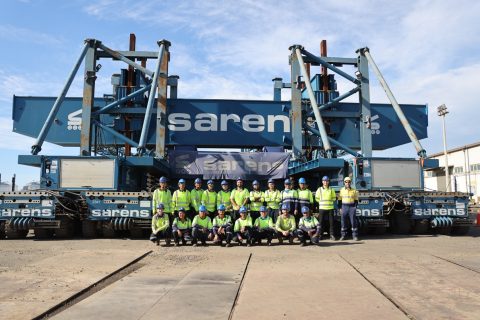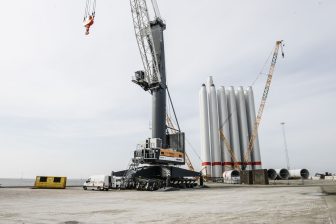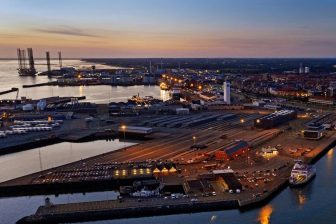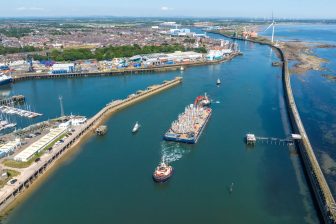
Sarens wraps up Formosa 2 scope
Sarens has completed the work scope for the Formosa 2 offshore wind farm at the Taichung Marshalling Harbour, Taiwan. The company lifted and transported 188 pin piles and 47 OWF Jackets at the marshalling yard for the client, Jan de Nul. The 376MW wind farm consists of 47 Siemens turbines atop jacket foundations placed in waters reaching 55-metre depths.
For Sarens, the project took place in five phases, load-in of the pin piles and transport to storage, load-out of the pin piles, load-out of the jackets in Batam, load-in of the jackets and transport to storage and preparation of the jackets for load-out.
In the first phase, Sarens was responsible for transporting 188 pin piles from the quay to the storage areas. These pin piles were huge, some measuring up to 80 meters long and weighing up to 280 tonnes. Sarens lifted them onto SPMTs using transportation vessel cranes and transported 25 pin piles within 72 hours. Sarens completed this phase within the agreed-upon timeframe and with the highest regard for safety.
During the second phase of the project, Sarens transported 188 pin piles from the long-term storage areas to the temporary quayside storage, which allowed for fast loading activities. To transport the pin piles, Sarens used 28 axle lines of SPMTs. Loading was carried out using LR 11350 crane with superlift. The timing was crucial during this phase, and Sarens achieved the loading of eight pin piles within a 12-hour timeframe, which was a challenging goal considering the necessary modifications that had to be made to the crane’s superlift to adjust it from 500T to 250T.
In Batam, a team of experts facilitated the transportation of jackets to the Indonesian islands. The jackets were loaded using a second jacket handler, an additional set of SPMTs, and Sarens’ custom-designed jacket handler that came equipped with 120 axle lines of SPMT and 4 PCJ500 towers. The integrated jacking system enabled a streamlined alignment and lifting operation, allowing Sarens to load and transport a jacket during every suitable tide. Usually, four jackets were offloaded per 48 hours. The jackets weighed up to 1700 tonnes and the load-in process began in the third quarter of 2021.
In the final phase, Sarens helped in preparing the jackets for load-out in Taiwan. This involved installing a lifting adapter piece to each of the 47 jackets, which required a dedicated GWO-trained lifting team and utilized a crane with plate number 1.
While stationed at Taichung Port, Sarens faced multiple challenges related to permissible ground loading. They had to redistribute transport loads into the quay piles and ensure adequate load spreading. Sarens also had to deal with ground degradation due to extreme rainfall and mobilize additional equipment to overcome a mid-project reduction in port limitations. Despite these challenges, Sarens and its partners, Jan De Nul, remained focused and ready to ensure that the project continued to meet its targets.
You just read one of our premium articles free of charge
Register now to keep reading premium articles.




